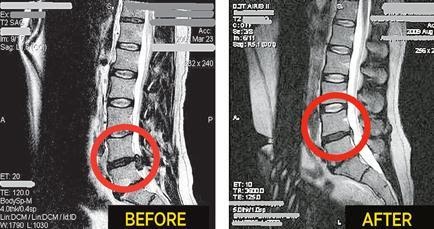 Disc injuries are serious injuries and can lead to necessary surgery. Once a disc is injured, the damage is permanent. The disc is the cushion or shock absorber between each vertebra. The inner part of the disc contains a gel-like substance that helps absorb compressive forces. Damage to the outer layer of the disc will cause the gel to either bulge or squirt out. This will take up space and irritate or compress the spinal nerve exiting a small hole on the side of the spine. Irritating or compressing the nerve will interfere with the information being sent by the nerve, resulting in pain, numbness, and/or muscle weakness somewhere along the nerve’s path. For the neck, this means in the arm, for the low back, it means in the leg.
Disc injuries are serious injuries and can lead to necessary surgery. Once a disc is injured, the damage is permanent. The disc is the cushion or shock absorber between each vertebra. The inner part of the disc contains a gel-like substance that helps absorb compressive forces. Damage to the outer layer of the disc will cause the gel to either bulge or squirt out. This will take up space and irritate or compress the spinal nerve exiting a small hole on the side of the spine. Irritating or compressing the nerve will interfere with the information being sent by the nerve, resulting in pain, numbness, and/or muscle weakness somewhere along the nerve’s path. For the neck, this means in the arm, for the low back, it means in the leg.
There are only 2 ways to move this disc material off of the nerve. Either physically, by going in with a knife, or using negative pressure. The disc had an air-tight seal holding the gel inside until the injury to the outer part of the disc. Disc decompression pulls to separate the vertebrae, creating negative pressure and pulling the gel back into the disc and off of the nerve. See the corresponding image on how disc decompression retracts the disc material and thickens the disc.
Lumbar disc surgeries are less than 50% successful.
Even if successful, it usually involves fusing the 2 vertebrae together. This puts excessive stress on adjacent discs since those vertebrae are forced to move more to make up for the lack of motion at the adjacent segment. It is only a matter of time until a disc adjacent to a fusion starts to break down.
With any medical issue, you should always start with the least invasive forms of treatment and move to more invasive if they are unsuccessful. Disc decompression, combined with chiropractic treatment should be the first form of treatment you try. Disc decompression has very high success rates for both neck and low back. We have resolved disc problems in hundreds of patients, eliminating the need for surgery. Many patients sought our care as a means to help them “just make it” until their surgery date and never ended up getting the surgery. No treatment is 100% effective. If disc decompression therapy and chiropractic care do not resolve your issue, the next step is epidural injections and the final step is surgery. In rare instances, our treatments do not work, we can refer you to one of our trusted neuro or orthopedic surgeons in our referral network.

Treatment Information.
Each patient and their conditions are unique. Treatment results and protocols will differ. Treatment may last 25 to 40 minutes. Patients will be fully clothed and lying in a face-up position. The doctor fits you with a harness around your pelvis and another around your trunk. For the cervical traction, the patient will be face-up and fitted with a neck harness.
Recent Research
Recent research has shown that 86% of the 219 patients who completed decompression therapy reported immediate resolution of symptoms, while 84% remained pain-free 90 days post-treatment. Physical examination findings showed improvement in 92% of the 219 patients and remained intact in 89% of these patients 90 days after treatment (Gionis, Thomas MD; Groteke, Eric DC. Surgical Alternatives: Spinal Decompression. Orthopedic Technology Review. 2003; 6 (5).
Let us help you feel at your best.
Feel free to contact us if you have any questions, your wellbeing is our priority.
